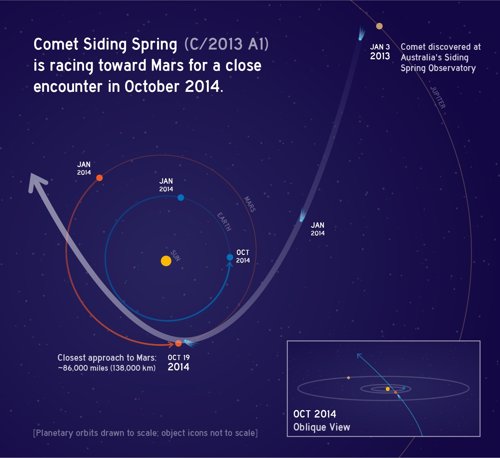
: ESA
MADRID, 7 Feb. (IRIN) –
One of the most interesting events of planetary exploration in 2014 is potentially the most dangerous also for spacecraft in orbit around Mars .
Sunday, October 19, at about 18:30 GMT, the comet C/2013 A1 – widely known as ‘Siding Spring’ after the observatory which was discovered in January 2013 – will make a close flyby of Mars
.
the second comet will visit Mars in 12 months, following the comet ISON last October. However, ISON spent about ten million miles from the planet, and current estimates put Spring Sidi just 136,000 miles from the surface of Mars , representing one third of the distance from the Earth to Moon, a very short distance to a comet.
In a post published on the blog of the Martian orbital mission of the ESA (Mars Express), stresses that while the comet will not collide with Mars observing the initial data lead us to believe that the cloud of dust that surround the nucleus of the comet will be large enough to envelop Mars and therefore the orbit of the spacecraft around the planet.
Three orbiters are currently active on Mars : Mars Reconnaissance Orbiter (MRO) and Mars Odyssey, NASA, and Mars Express, ESA. Two more left Earth at the end of 2013 and should enter orbit around Mars about three weeks before the comet maqrciana overflying the atmosphere: Mars Atmosphere and Volatile Evolution (MAVEN) and Mars orbiter India.
addition comet observation allow better predictions of the actual size of this cloud of particles and the level of risk to spacecraft orbiting Mars. In this event, the operations team of the European mission and has begun to consider ways to better protect the Mars Express cloud of dust comment .
particles are expected to be large. with up to an inch in diameter. However, the amazing speed of 56 kilometers per second will move 200 000 kilometers per hour. They
At these speeds, even dust can be dangerous. Electromagnetic pulses and possible plasma clouds generated by the velocity of the particles can cause problems in electronic systems of the ships.
Siding Spring is currently 670 million kilometers from Mars, a distance it will cover in just nine months.
No comments:
Post a Comment